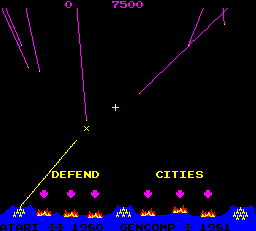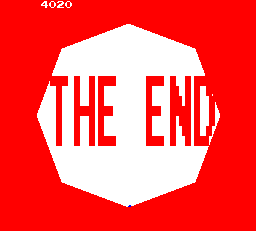Super Missile Attack
Mirrored from Kev's lawnmowerman
page
Last updated: February 19, 2003
|

GENERAL COMPUTER CORPORATION
1726 Beacon Street
Boston, MA 02146
|
It's here! The game enhancement you've been waiting for - SUPER MISSILE
ATTACK. (tm) Designed by General Computer for your Atari MISSILE COMMAND
(tm) Cabinet, it breathes new life into a proven winner.
The simple insertion of a plug-in circuit gives new dimensions
to your MISSILE COMMAND (tm) Game. Increase excitement, difficulty, and
your revenues.
SUPER MISSILE ATTACK (tm) is a software enhancement. All the characteristics
that made MISSILE COMMAND (tm) a champion have been retained or improved.
SUPER MISSILE ATTACK (tm) is a cashbox winner in test locations. Set the
operator selectable difficulty levels and make it a winner in yours.
A General Computer Software Enhancement is your best equipment investment
today. For about 10% of the price of a new game you can get your original
investment in your MISSILE COMMAND (tm) working hard for you today. $295.00
Each (From Play Meter magazine ad July 1, 1981)
|
 |
From the installation kit, May 2, 1981 Version SMA-02E.1
Super Missile Attack is an entirely new concept in video game enhancements.
Super Missile Attack is not a simple speed-up kit, but a genuine software
improvement of the existing software in your ATARI (tm) Missile Command
(tm) game. Software is the language that a video game is written in -
changing the language will change the game. Super Missile Attack by General
Computer builds on the software provided by ATARI to give you more challenge,
more excitement and, of course, more profit from your existing game.
|
Features include:
- A new look to the game: different colors, different attract mode,
etc. shout "Play-me!" to the video game enthusiast.
- A new sound to the game: each attack object now has its own brand-new
sound that lets everyone know that this is no ordinary Missile Command.
- A new play to the game: more missiles, faster missiles and clouds
that get smaller as the game goes on add challenge (and profit) to your
Missile Command box. Plus a Totally New Attack Object, the "UFO", which
moves faster and more randomly than ordinary planes and satellites and
fires a deadly new Laser weapon.
|
 |
- A new theory behind the game: the old Missile Command settled for
plain hard - but not hard enough. Super Missile Attack keeps the early
rounds easy (to attract those first quarters), makes the intermediate
rounds more interesting (to excite the casual player) - then makes sure
the expert doesn't play forever!
|
 |
Operation
The Super Missile Attack game has four operator selectable levels of difficulty.
They are selected through the use of the toggle switches on the Atari game PCB.
Toggle Settings of 8-Toggle Switch on Game PCB (@R10)
Dipswitch Settings
| 8 |
7 |
6 |
Option |
| On |
On |
On |
ordinary Missile Command |
| On |
Off |
On |
easy Super Missile Attack |
| Off |
On |
On |
reg. Super Missile Attack |
| Off |
Off |
On |
diff. Super Missile Attack |
Ordinary Missile Command -- The regular version of Atari's Missile Command
is still available by setting the toggle switches. This feature is useful when
the game is moved to a new site which doesn't have skilled Missile Command players.
When the players become skilled and revenues decrease due to increased duration
of average game you may consider switching to....
Easy Super Missile Attack -- one of two of our suggested settings. It
is the easiest of the three versions of Super Missile Attack available. New
colors and sounds alert the regular player that this game is no longer ordinary
Missile Command. The screen multiplier progresses 1X (twice), 2X (twice), ...
, 10X (until end). Each screen has two more attacking missiles and one more
smart missile per screen than Atari's Missile Command Game. At 4X the new attack
object, the UFO appears, and on 5X the UFO begins to fire his high powered laser.
The novice will play for nearly as long as he would on ordinary Missile Command,
but the skilled player must modify his strategy or be out to the game. At higher
multipliers, the explosions generated by the defensive missiles begins to shrink
in size and duration. In the later screens, the incoming missiles begin to travel
faster than ever before.
Regular Super Missile Attack -- The second of our two suggested settings.
It is very challenging version of Super Missile Attack. The screen multiplier
progresses 1X (once), 2X (once), ... , 10X (until end). Each screen has four
more attacking missiles and two more smart missiles per screen than Atari's
Missile Command Game. This setting gets increasingly difficult more than twice
as fast as easy Super Missile Attack. This is the recommended setting for very
high skill locations where players regularly score 1,000,000 points. A million
point player will be limited to 50,000-80,000 very fast points.
Difficult Super Missile Attack -- The most difficult of the three versions
of Super Missile Attack. The screen multiplier progresses 1X (once), 2X (once),
... , 8X (until end). Each screen has six more attacking missiles per screen
and three more smart missiles than the ordinary Missile Command game. The difficult
setting's initial screens are difficult. They also get more difficult at a faster
rate than the easy and regular settings.
All the operator selectable features of the original Missile Command are still
available except for two small changes. Only one language is available to the
operator. Yours is English. Please contact the factory for other languages.
The other difference is that in order to run self-test mode, you must remove
the Super Missile Attack board and reinsert the Atari ROMs.
*****
SMA requires -02 version ROMs. It will also work identically with version -03E
(035822-03E) ROM but will not work with -01 ROMs.
The original SMA auxiliary PCB is approx. 7" square and has...
- 2 24-pin ribbon cables that connect to H1, R1.
- 4 single wire sockets that connect to J/K1, K/L1, L/M1, N/P1 pin 20 (CE).
- 2 additional 2516 EPROMs E0 = $41C6 and E1 = $7A9B
- 2 additional 63S141 PROMS left = $06AB and right = $0747
- a 74LS138
- a 74148
- either a GAL or custom PROM?
How SMA was decrypted
Unable to decipher what the one mystery chip on the PCB was, I felt all hope was
lost for reproducing the board until I realized that this unit was simply a ROM
replacement and that the purpose of the board is to patch in the code changes
as needed. I am lucky to have a Cat Box (Atari test unit), so I first read
the ROM locations for the new checksums. Next I rigged up a patch cable
that inserts into my Needhams PB-10 EPROM burner. Basically the PB-10 end
of the patch cable is a 40 pin wire wrap wired as a 512 format EPROM. The
other end of the patch cable fits the Atari Cat Box connector end, specifically
matching the Address and Data lines. From this I was able to read the memory
contents as if it were a EPROM and save them to disk. This worked fine except
for the last EPROM file, for some reason it would not read properly at it's normal
location on the board. I was able shift the SMA board 1 socket (leaving
the first socket hanging) and read it as the next to last ROM fine.
With code in hand I sought out a MAME programer to help, Mike Balfour has been
very helpful in the past and was able to confirm the code worked (and point
out 1 small error).
Note that the SMA code circulating
with MAME is not the original ROM chips, but the final result of the patching.
History of General Computer Corporation
GCC completed several games for Atari including Quantum and Foodfight, and
early development work on Tunnel Hunt (?) and Nightmare. GCC also made a hack
for Pac-Man called 'Crazy Otto' which had a character with legs that would chase
the monsters. The 'hack' eventually led to the creation of Ms. Pac-Man. GCC
also worked on Jr. Pac-Man.
Guy Hillyer was nice enough to point out that GCC was still in business and
could be found at http://www.gcctech.com
including a little snipet of their history.
Quoted from their page...
"GCC was founded in 1981 during the onset of the video game craze. C.E.O.
Kevin Curran and MIT classmates Doug Macrae and John Tylko began by developing
an enhancement for Atari's 'Missile Command' and went on to create 'Ms. Pac
Man', still one of the top-selling coin-operated video games in history. Between
1982 and 1984, GCC developed a total of 58 consumer electronics products that
generated over $800 million in revenue for Atari and Bally Manufacturing."
Stephen Swanson was kind enough to write in and had the following to say:
"I worked for GCC back in the late 80's, and got to know many of the guys
who made the video
games in the previous years, although by that time the company had moved on
to creating
Macintosh hardware and software almost exclusively.
Some of the names have faded, but some of the key game creators were Chris Rode,
Seth Lipkin,
Dave Brown, Jacques Hugeau (not sure of the spelling), and a few others I can't
remember just now.
The company changed its name in '88 or '89 from General Computer Corporation
to GCC
Technologies because some other company had the name first and threatened to
sue.
Originally based in Cambridge Mass, they moved to 580 Winter Street, Waltham
Mass a few years
before I started there in 1987.
An interesting note: in about 1984, Chris Rode bought a Porsche 911 with some
of his video game
royalty money, and within a matter of a few weeks or a month, rolled and totaled
it (he wasn't hurt,
as I recall). Interesting times.
GCC also made some games for the Mac in the mid 80's, under the name Mind Sports,
and the one
I remember was similar to Super Missile Attack but with a different title I
can't remember. I may even
have a copy around somewhere.
GCC also created Miss Pacman for the Atari 2600, and interestingly created the
first hard drive for
the Macintosh even before Apple did, called the HyperDrive. The 20 Mb version
had reliability
problems and almost ruined the company. They also created the first non-PostScript
laser printer
called the Personal Laserprinter.
By the way, Atari threated to sue General Computer because of Super Missile
Attack because of
copyright infringement, but at that point GCC was comprised of two poor students
(Kevin Curran and
Doug Macrae -- MIT classmate John Tylco joined up later, as I remember) and
so Atari offered them
more work instead. Truely an offer they couldn't refuse. They were all MIT dropouts
(with the possible
exception of Tylco) by the way. It was the Atari offer they didn't want to (or
couldn't) pass up that
convinced them to drop out."
|
Kev
mowerman@erols.com
http://www.erols.com/mowerman
Anyone able to help with the history of General Computer Corporation
please drop me a note!
|
 |
